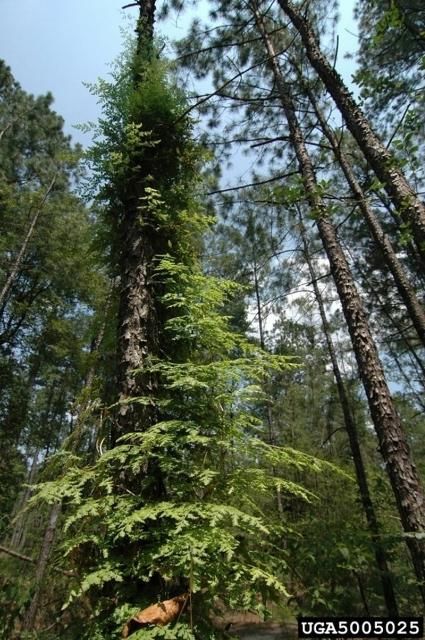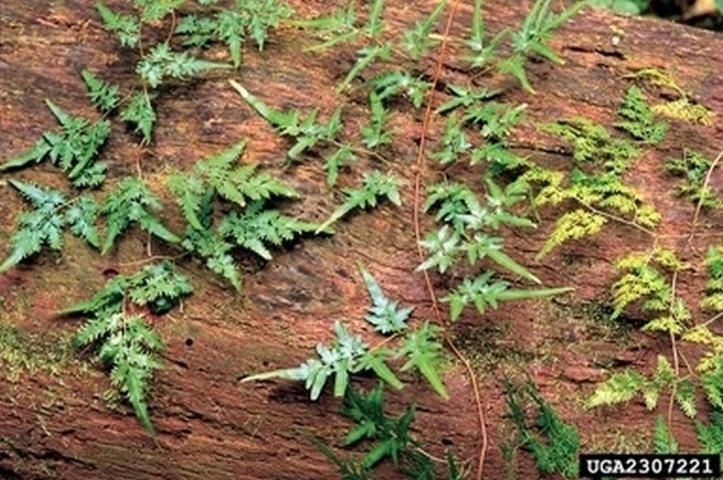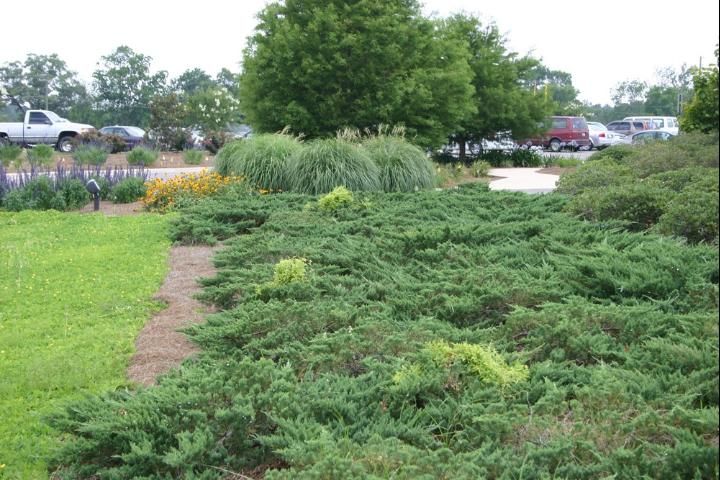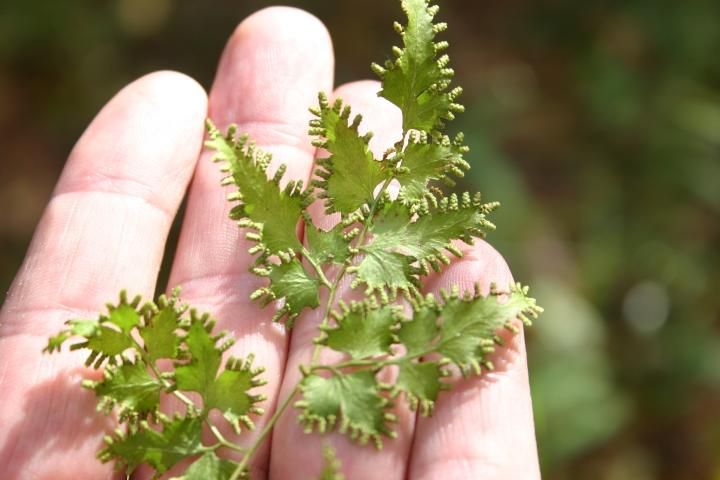Japanese climbing fern (Lygodium japonicum (Thunb.) Sw.) is a non-native, invasive vine that from its introduction around 1900 has become established throughout the southeastern Coastal Plain from the Carolinas to Texas and Arkansas. It is native to eastern Asia from Japan and west to the Himalayas. The naturalized area has expanded from the Gulf States region to include TX, AR, LA, MS, AL, FL, GA, SC, NC, and PA (USDA Plant Database 2016). In Florida, climbing fern is widespread in north and west Florida and ranges into the south-central part of the Florida peninsula (Nelson 2000; Wunderlin et al. 2016). It occurs in sunny or shady locations, usually in damp areas such as the edges of swamps, marshes, lakes, creeks, hammocks, and upland woodlands (Langeland and Cradock Burks 1998).

Credit: Ronald F. Billings, Bugwood
Biology
Japanese climbing fern has climbing, twining fronds of indeterminate growth and can reach lengths of 90 feet. Above-ground growth occurs along wiry main stems, properly called "rachises" (the singular is "rachis"). Japanese climbing fern is closely related to Old World climbing fern (Lygodium microphyllum), another non-native invasive species in the United States. Both species are listed as Category I noxious weeds by the Florida Exotic Pest Plant Council, with the ability to "alter native plant communities, change community structures and ecosystem function" (FLEPPC 2016). Japanese climbing fern is also listed as a Class B noxious weed in Alabama (USDA Plants Database 2016). Japanese climbing fern has feathery, light green fronds in contrast to the leathery appearance of Old World climbing fern, which usually has un-lobed leaflets that are glabrous (waxy) below and articulately stalked. While Old World climbing fern is limited in its northern range due to a lack of frost tolerance. Japanese climbing fern occurs as both individual scattered plants and as tangled masses of dense canopy that can eliminate the underlying vegetation and cover larger trees. As a fern, it reproduces by spores that are extremely numerous, long-lived, and readily disseminated. Moreover, it can reproduce by self-fertilizing. Pinnae on lower rachises are sterile; but as the rachis develops, successive new pinnae become increasingly fertile. Spore abundance increases through the growing season as the rachis grows. In north Florida, peak spore release occurs in October (Van Loan 2006). Japanese climbing fern also spreads vegetatively by rhizomes located 1 to 3 cm below the soil surface.

Credit: Ted Bodner, Bugwood
Rhizomes spread and re-sprout after winter frosts, and the fern rapidly grows back from rhizomes after being burned (Evans et al. 2006). However, no studies have reported the spread rates of fern by these vegetative means.

Credit: Chuck Bargeron
Japanese climbing fern poses both economic and ecological threats to forests in Florida. It is especially problematic in pine plantations managed for pine straw production. For years, pine straw bales have been a suspected vector of viable Japanese climbing fern plant parts and spores (Zeller and Leslie 2004).
The fern is also problematic during prescribed burning because it provides a fuel ladder to canopy trees. Further, because of its ability to engulf and out-compete native vegetation, Japanese climbing fern can be of particular concern in natural and disturbed areas where restoration of remnant populations of native species is critical.
Control Measures
Biological
Currently there are no published or on-going studies regarding biological control of Japanese climbing fern in the southeastern United States. Progress has been made, however, to identify selective biological control agents for Old World climbing fern (Pemberton 1998). In 2007, populations of the defoliating moth from Australia, Austromusotima camptozonal were released at nine locations of Old World climbing fern in Florida (Pemberton 2007). Breeding was detected at three locations, but there was no evidence of persistence or establishment of the insect. Researchers at the USDA Invasive Plant Research Laboratory (IPRL) in Ft. Lauderdale, Florida, are examining several other insect species as well, including lygodium gall mite (Floracarus perrepae), lygodium saw fly (Neostrombocerus sp.), flea beetles (Manobia sp.), and stem borers. The caterpillar stage of Neomusotima fuscolinealis is a natural pest of Lygodium japonicum in Japan but has yet to be tested for potential host range and environmental safety in Florida or the southeastern United States (Pemberton 2002).

Credit: Pat Minogue, UF/IFAS
Fire
Fire is not thought to be an effective means for control because the fern re-grows quickly following fires. A few researchers have examined the use of fire to control Old World climbing fern with little success (Munger 2005). Stocker et al. (1997) used a propane torch to burn off above-ground portions of Old World climbing fern and found that the ferns recovered speedily. Regarding efforts to control Old World climbing fern, Roberts (1997) concluded that fire alone will not control this invasive weed. Control of other invasive species with significant above-ground and below-ground biomass such as cogongrass (Imperata cylindrica) has been enhanced by using prescribed fire in conjunction with herbicide application (Jose et al. 2002). However, citing a personal communication, Ferriter (2001) stated that prescribed burns, alone and in combination with the herbicide 2,4-D, were not effective in controlling Japanese climbing fern in pine plantations in north Florida. More research is needed to examine the combined use of herbicides and fire to control existing climbing fern plants and those that may arise from numerous spores.
Herbicides
Herbicidal control of Japanese climbing fern has only been formally investigated by a few researchers (Valenta et al. 2001; Zeller and Leslie 2004; Van Loan 2006; Minogue et al. 2010). In a review of herbicide treatments for Old World climbing fern, Langeland (2016) noted that glyphosate and metsulfuron methyl, used alone or in combination, were most common. The effectiveness of glyphosate treatments was observed in early studies of Japanese climbing fern; however it was also noted that metsulfuron treatments were least damaging to surrounding native vegetation, particularly graminoids (Zeller and Leslie 2004; Minogue et al. 2010). Van Loan (2006) examined 15 herbicide treatments for selective control of Japanese climbing fern in three north Florida pine forests. She had best results using glyphosate, imazapyr, and metsulfuron methyl, herbicides that inhibit the formation of amino acids in plants. Minogue et al. (2010) and Bohn et al. (2011) examined these same herbicides for efficacy in controlling Japanese climbing fern and for their impact on associated vegetation using various herbicide rates and combinations at locations on conserved lands in north Florida. Early control of Japanese climbing fern improved linearly as the glyphosate product rate was increased from 1 percent to 4 percent of the spray solution, with nearly 100 percent cover reduction at 8 months after treatment using the 4 percent rate. However, at two years after treatment 5 to 16% cover was observed across the glyphosate rates, and they did not differ in effectiveness. Given that re-treatment was needed to control re-sprouting plants and new germinates, use of a 2% glyphosate solution was recommended to reduce costs and potentially avoid adverse effects to associated vegetation.

Credit: Pat Minogue, UF/IFAS
Combinations of glyphosate and metsulfuron methyl were generally more effective than combinations of glyphosate and imazapyr. Damage to associated vegetation, including overstory hardwood trees not sprayed with herbicide, was greatest with the persistent soil active herbicide imazapyr. Least injury to associated vegetation was with metsulfuron methyl. Native grasses quickly re-colonized treated plots at some locations. Miller (2007) recommends various herbicide treatments for control of Japanese climbing fern (see Table 1). When using metsulforon methyl (Escort®), be sure to add a surfactant (wetting agent) according to label directions to improve plant uptake. From operational experience, best results are obtained with application of these herbicides in late season, from July to early October, prior to peak spore release.
The use of trade names in this publication is solely for the purpose of providing specific information. UF/IFAS does not guarantee or warranty the products named, and references to them in this publication do not signify our approval to the exclusion of other products of suitable composition. All chemicals should be used in accordance with directions on the manufacturer's label. Use pesticides safely. Read and follow directions on the manufacturer's label.
PLEASE READ AND FOLLOW ALL HERBICIDE LABEL DIRECTIONS.
References
Bohn, K. K., P. J. Minogue, and E. C. Pieterson. 2011. "Control of invasive Japanese climbing fern (Lygodium japonicum) and response of native ground cover during restoration of a disturbed longleaf pine ecosystem." Ecological Restoration 29:346–356.
Evans, C. W., D. J. Moorhead, C. T. Bargeron, and G. K. Douce. 2006. Invasive Plant Responses to Silvicultural Practices in the South. University of Georgia Press.
Ferriter, A. ed. 2001. Lygodium management plan for Florida: A report from the Florida Exotic Pest Plant Council's Lygodium Task Force. Florida Exotic Pest Plant Council. Orlando, FL. 51 pp.
FLEPPC. 2016. "Florida Exotic Pest Plant Council Invasive Plant Lists." https://floridainvasivespecies.org/plantlist.cfm (accessed January 10, 2023)
Jose, S., J. Cox, D. L. Miller, D. G. Shilling, and S. Merritt. 2002. "Alien plant invasions: the story of cogongrass in southeastern forests." Journal of Forestry 100(1):41–44.
Langeland, K. A. 2021. Natural area weeds: Old World climbing fern (Lygodium microphyllum). SS-AGR-21. Gainesville: University of Florida Institute of Food and Agricultural Sciences. https://edis.ifas.ufl.edu/publication/AG122
Langeland, K. A. and K. Craddock Burks (ed.) .1998. Identification and Biology of Non-Native Plants in Florida's Natural Areas. University of Florida, Institute for Food and Agricultural Sciences. 165 pp.
Lott, M. S., J. C. Volin, R. W. Pemberton, and D. F. Austin. 2003. "The reproductive biology of the invasive fern Lygodium microphyllum and L. japonicum (Schizaeaceae): Implications for invasive potential." American Journal of Botany 90:1142–1154.
Miller, J. H. 2007. Non-native Invasive plants of southern forests. US Department of Agriculture, Forest Service, Southern Res. Stn., Gen. Tech. Rpt. SRS-62. 93 pp.
Minogue, P. J., K. K. Bohn, A. Osiecka, and D. K. Lauer. 2010. "Japanese climbing fern (Lygodium japonicum) management in Florida's bottomland hardwood forests." Invasive Plant Science and Management 3:246–252.
Munger, G. T. 2005. "Lygodium spp." In: Fire Effects Information System. U.S. Department of Agriculture, Forest Service, Rocky Mountain Research Station, Fire Sciences Laboratory (Producer) https://www.fs.usda.gov/database/feis/plants/fern/lygspp/all.html (accessed January 10, 2023)
Nelson, G. 2000. The Ferns of Florida. Pineapple Press, Sarasota, Florida. 208 pp.
Pemberton, R. 2007. Lygodium biological control. 2007 Annual Report, USDA, Agricultural Research Service, Invasive Plant Research Laboratory, Ft. Lauderdale, FL. http://www.ars.usda.gov/research/projects/projects.htm?ACCN_NO=406789&showpars=true&f y=2007 (accessed January 10, 2023)
Pemberton, R. 2002. "Old-World climbing fern." In: Van Driesche, R. et al. (eds.) Biological Control of Invasive Plants in the Eastern United States. USDA Forest Service Publication FHTET-2002-04. 413 pp.
Pemberton, R. W. 1998. "The potential of biological control to manage Old-World climbing fern (Lygodium microphyllum), an invasive weed in Florida." American Fern Journal. 88(4):176–182.
Roberts, D. 1997. Old-World climbing fern research and mitigation at Jonathan Dickinson State Park. Resource Management Notes. Florida Department of Environmental Protection, Florida Park Service. Orlando, FL. 9(2):30–32.
Stocker, R. K., A. Ferriter, D. Thayer, M. Rock, and S. Smith. 1997. "Old-World Climbing Fern Hitting South Florida below the Belt." Wildland Weeds (Winter):6–10.
USDA, NRCS. 2023. PLANTS profile: Lygodium japonicum (Thunb.) Sw. National Plant Data Center, Baton Rouge, LA 70874-4490. https://plants.usda.gov/home/plantProfile?symbol=LYJA (accessed January 10, 2023)
Valenta, J. T., M. Zeller, and A. Leslie. 2001. "Glyphosate control of Japanese climbing fern in experimental plots (Florida)." Ecological Restoration 19:118–119.
Van Loan, A. N. 2006. "Aspects of the Invasion and Management of Japanese Climbing Fern (Lygodium japonicum) in Southeastern Forests." M.S. Thesis. University of Florida. 119 pp.
Wunderlin, R.P. B.F. Hansen, A.R. Franck, and F.B. Essig. 2023. "Lygodium japonicum", Atlas of Florida Plants [S. M. Landry and K. N. Campbell (application development), USF Water Institute] Institute for Systematic Botany, Univ. of South FL, Tampa, FL. https://florida.plantatlas.usf.edu/Results.aspx (accessed January 10, 2023)
Zeller, M. and D. Leslie. 2004. "Japanese climbing fern controls in planted pine." Wildland Weeds 7:6–9.